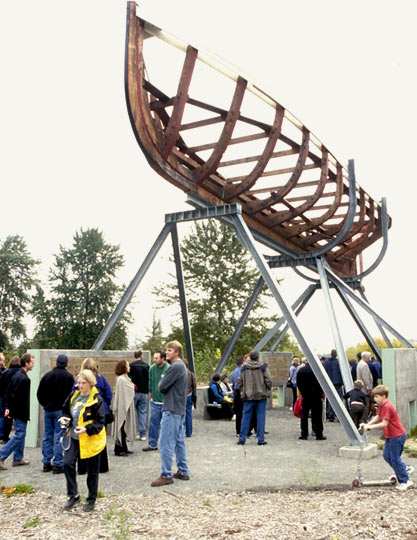Alki/Duwamish Culture Trail
Seattle, Washington
Every part of this country is sacred to my people. Every hillside, every valley every plain and grove has been hallowed by some fond memory or sad experience of my tribe, even the rocks which seem to lie dumb as they swelter in the sun along the silent seashore in solemn grandeur thrill with memories of past events connected with the lives of my people.
– Chief Sealth

In 1998, The City of Seattle named Fels artist in residence for the area where the city first began; now called West Seattle. In preparation of the 150th anniversary celebration of the city’s founding, the Seattle Arts Commission had in mind the creation of a series of monuments for the ‘settlers’ who named the area. With Native American artists Joe Fedderson and Jaune Quick-to-see Smith, Fels set out to research the lesser known histories of the area. The artists interviewed many residents, met with community groups, historians, scientists and archaeologists, hung out in parks, cafes, bars, and at local businesses, read widely, and looked into archives. The research resulted in over a hundred discrete artworks, broadly treating a century and a half of history. They commissioned poetry, prose, and photographs; all were included in the popular walkway along Alki Beach, which attracts upwards of a million visitors annually.
Working with optics designer Edward Mannery, Fels designed a series of viewers for Alki. Employing mirrors, natural illumination and no moving parts, the viewing devices allow visitors to see an historic photograph superimposed over the current view. The result is rather magic; a ghost image floats before the eyes. Underfoot, an etched paver provides historic background. The City of Seattle has created two editions of a complete guidebook to the artworks.
With the Alki Beach artworks complete, Quick-to-See and Fedderson returned to their studio work. Fels continued on with the trail as it meandered along the Duwamish Waterway, the industrialized section of the city. He made contact with the Port of Seattle, which controls much of the riverside property. By partnering with the Port, Fels was able to considerably broaden and enrich the scope of the original project. He worked closely with environmental engineer George Blomberg, who represents Port interests along the Duwamish. Fels designed a series of sculptural installations for Terminal 107, which the Port wanted to turn into a park. The City of Seattle paid Fels' design fees; the Port provided a contracting team and underwrote all construction costs.
Over the next few years, Fels created three distinct artworks for the site, most prominently “Paragon”, an eighty foot wooden hull of a halibut schooner, built by boatbuilding students at Bates Technical College, a partnership developed by Fels. The students worked on the fir skeleton for two years, using traditional wooden boat building techniques to shape salvaged first growth timbers. The schooner frame was taken from plans of a 1923 fishing boat of a type once designed and built along the river.
The steel and concrete support that Fels designed to hold the Paragon up in the air contains panels telling of the boatbuilding community that once lived on site. Testament to the goodwill between Fels and the Port of Seattle, the panel text pulls no punches about the role of the Port in evicting the resident boat builders. Other texts tell about the design tradition of the vessels, and the Native peoples who once lived on the surrounding land.
After completing the Paragon, Fels was contacted by Blomberg when Brian Atwater, a noted USGS/University of Washington geologist, was planning to take earth samples at the site. Having seen how Fels incorporated history into his work, Blomberg guessed (correctly) that he and Atwater would work well together. Atwater brought in a distinguished team of scientists from the U.S. and from the Japanese Geological Survey to survey the history of the site. Excited about the possibility of making art there with the scientists, Fels contacted the Seattle Art Commission, and was funded to create a sculpture entailing their findings.
“Geo-Slice” is sited just east of Paragon. The sculpture enacts in metal what the scientists found beneath it. Fels cast in iron earth samples taken from fifteen feet down. The fifteen foot tall sculpture clearly displays the stratification of the ground. Atwater collaborated with Fels on its design and to create a key at the sculpture’s base that interprets the geology. The sculpture tells a dramatic story of a mudflow unleashed from Mt. Rainier many centuries ago. Fels partnered with Tacoma’s Urban Accessories to cast the iron from molds he had made of the earth sections. Having met on the Duwamish, Fels and Atwater continue to collaborate on other projects.
The Duwamish River has always been rough around the edges. Fels devised artwork that would honor the contradictory quality of a place that has long been out of the way yet lays just minutes from Seattle’s downtown. He makes no attempt to prettify what has gone on there, and chose industrial grade materials which have already had a life along the river. Taken directly from river work, the sculptural forms display a tough grace that beautifully befits the place.